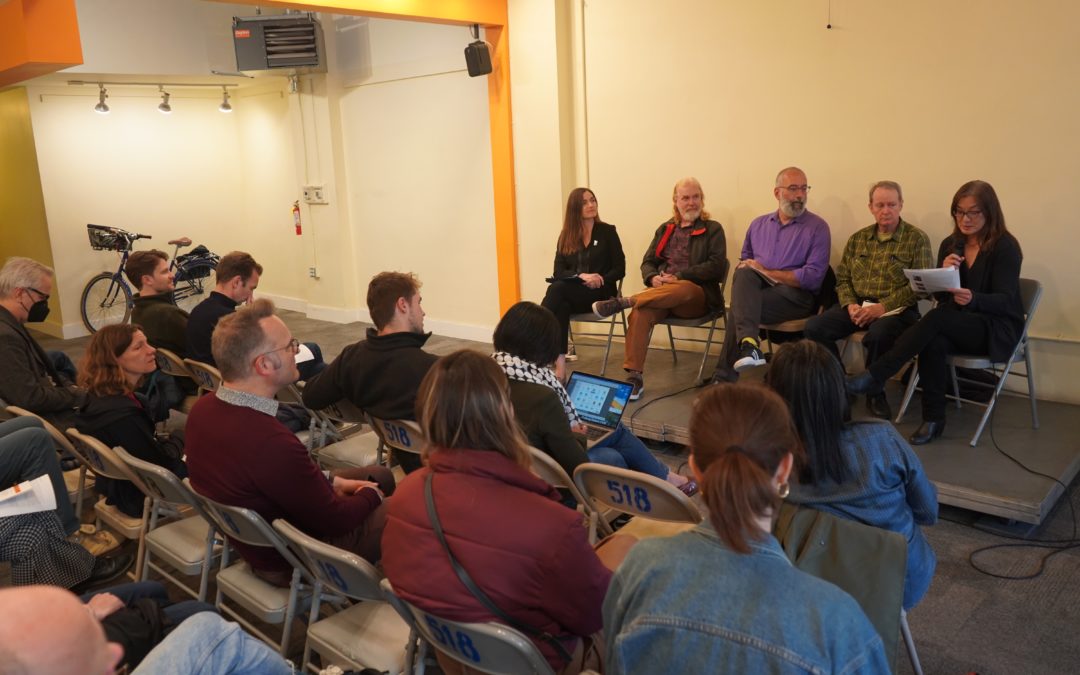We spent a Thursday evening in April at the humble and atmospheric 518 Valencia in San Francisco talking about ‘Moving for a Greener Future: The Climate Case for Public Transit.’ So if public transit contributes to 1 percent of San Francisco’s emissions, how can we really rally in changing public sentiment towards greater use of public transportation?
The conversation moderated by Ellen Wu, Executive Director at Urban Habitat, was unapologetically grim on occasions. “If global temperatures rose two degrees or more, we’ll be on an irreversible course,” remarked John Anderson, 350 San Francisco. The conversation also turned lively at times with a back and forth of candid responses from Amanda Eaken, SFMTA and NRDC and Tom Radulovich, Livable City on fare free transit and lower-cost transit and then between Radulovich and Anderson over the promise and limitations in electrical vehicles. Eaken further lent an air of levity and inspiration reminding the audience of the joys of transit with her reference to the recent SOMArts Muni Raised Me Art Exhibit: “What if one of every two hundred busses is an art bus, or one of every thousand rides you get to DJ” while the conversation came to a full circle when Jason Henderson, San Francisco State University, offered a glimpse of a hopeful horizon: “People really can significantly and quickly change their behaviors; there can be a rapid mobilization. For example, when the covid lockdowns happened, people generally complied, despite the politically polarized environment in the country.” Countless success stories from elsewhere in the United States and globally of what is plausible are here amidst the risks and unintended consequences of climate change.
I had been particularly curious to hear more about the climate justice equation — how to prioritize efforts on addressing the disproportionate impacts from pollution and traffic violence on low-income communities. And I was delighted by Radulovich’s attempt on making the simple yet elegant connections: “So if we think about climate justice, we need to think about health, as well — and hence the importance of infrastructure for livable cities through biking and walking…We also need to consider things such as: as we phase out polluting industries, how do we help people transition into new jobs?” Talking to some climate justice advocates last week, it is clear that the connection with public transit in their conversations is still nascent. While their movement has offered a crucial framework of a ‘Just Transition’, the question about its full implementation remains. For instance, how could we embrace the transformational changes that disadvantage communities have needed and demanded for so long and make the shift from ‘venture capitalism’ and ‘carbon capture’ to ‘energy democracy’ where it connects with public transportation? What role can San Francisco Transit Riders play specifically in this regard? Because otherwise, like our previous pandemic approaches have shown we can continue to focus on combating the symptoms and never on the root causes of our deteriorating nature and health.
As we ran our membership drive to engage with more of you in April, a humble thanks to the existing members who renewed and to the new members/riders who expressed interest in our work during our Earth Day tabling event. Because of your continued partnership we are well poised to pursue these crucial questions that lie the core of our climate change and racial justice risks.


